A Novel Tool for Supervised Segmentation Using 3D Slicer
Abstract
1. Introduction
2. Materials and Methods
3. Results and Discussion
4. Conclusions
Supplementary Materials
Author Contributions
Funding
Conflicts of Interest
Abbreviations
| BraTS | Brain-Tumor Segmentation |
| FL | Fluid-Attenuated Inversion Recovery |
| LGG | Low-Grade Glioma |
| MCS | Multiple Classifier System |
| OOB | Out Of Box |
| RVM | Relevance Vector Machine |
| RF | Random Forest |
| SVM | Support Vector Machine |
References
- Fedorov, A.; Beichel, R.; Kalpathy-Cramer, J.; Finet, J.; Fillion-Robin, J.C.; Pujol, S.; Bauer, C.; Jennings, D.; Fennessy, F.; Sonka, M.; et al. 3D Slicer as an image computing platform for the Quantitative Imaging Network. Magn. Reson. Imaging 2012, 30, 1323–1341. [Google Scholar] [CrossRef] [PubMed]
- Mehrtash, A.; Sedghi, A.; Ghafoorian, M.; Taghipour, M.; Tempany, C.M.; Wells, W.M.; Kapur, T.; Mousavi, P.; Abolmaesumi, P.; Fedorov, A. Classification of Clinical Significance of MRI Prostate Findings Using 3D Convolutional Neural Networks. Proc. SPIE Int. Soc. Optical Eng. 2017, 10134. [Google Scholar]
- Zhang, Y.; Dong, Z.; Wang, S.; Ji, G.; Yang, J. Preclinical diagnosis of magnetic resonance (MR) brain images via discrete wavelet packet transform with Tsallis entropy and generalized eigenvalue proximal support vector machine (GEPSVM). Entropy 2015, 17, 1795–1813. [Google Scholar] [CrossRef]
- Zhang, Y.; Wang, S.; Phillips, P.; Dong, Z.; Ji, G.; Yang, J. Detection of Alzheimer’s disease and mild cognitive impairment based on structural volumetric MR images using 3D-DWT and WTA-KSVM trained by PSOTVAC. Biomed. Signal Process. Control 2015, 21, 58–73. [Google Scholar] [CrossRef]
- Wang, S.; Li, Y.; Shao, Y.; Cattani, C.; Zhang, Y.; Du, S. Detection of dendritic spines using wavelet packet entropy and fuzzy support vector machine. CNS Neurol. Dis.-Drug Targets 2017, 16, 116–121. [Google Scholar] [CrossRef] [PubMed]
- Zhang, Y.; Yang, Z.; Lu, H.; Zhou, X.; Phillips, P.; Liu, Q.; Wang, S. Facial emotion recognition based on biorthogonal wavelet entropy, fuzzy support vector machine, and stratified cross validation. IEEE Access 2016, 4, 8375–8385. [Google Scholar] [CrossRef]
- Zheng, Q.; Wu, Y.; Fan, Y. Integrating semi-supervised and supervised learning methods for label fusion in multi-atlas based image segmentation. Front. Neuroinform. 2018, 12, 69. [Google Scholar] [CrossRef] [PubMed]
- Amiri, S.; Mahjoub, M.A.; Rekik, I. Tree-based Ensemble Classifier Learning for Automatic Brain Glioma Segmentation. Neurocomputing 2018, 313, 135–142. [Google Scholar] [CrossRef]
- Cortes, C.; Vapnik, V. Support-vector networks. Mach. Learn. 1995, 20, 273–297. [Google Scholar] [CrossRef]
- Chang, C.C.; Lin, C.J. LIBSVM: A library for support vector machines. ACM Trans. Intell. Syst. Technol. 2011, 2, 1–27. [Google Scholar] [CrossRef]
- Schölkopf, B.; Smola, A.J.; Williamson, R.C.; Bartlett, P.L. New support vector algorithms. Neural Comput. 2000, 12, 1207–1245. [Google Scholar] [CrossRef] [PubMed]
- Ho, T.K. Random decision forests. In Proceedings of the 3rd International Conference on Document Analysis and Recognition, Montreal, QC, Canada, 14–16 August 1995; pp. 278–282. [Google Scholar]
- Chalupa, D. Supervised Segmentation Toolbox for 3D Slicer. Source Code Available Under the GNU General Public License v3.0. Available online: https://github.com/chalupaDaniel/slicerSupervisedSegmentation (accessed on 14 October 2018).
- King, D.E. Dlib-ml: A machine learning toolkit. J. Mach. Learn. Res. 2009, 10, 1755–1758. [Google Scholar]
- Igel, C.; Heidrich-Meisner, V.; Glasmachers, T. Shark. J. Mach. Learn. Res. 2008, 9, 993–996. [Google Scholar]
- Kapás, Z.; Lefkovits, L.; Szilágyi, L. Automatic Detection and Segmentation of Brain Tumor Using Random Forest Approach. In Modeling Decisions for Artificial Intelligence; Springer: New York, NY, USA, 2016; pp. 301–312. [Google Scholar]
- Menze, B.H.; Jakab, A.; Bauer, S.; Kalpathy-Cramer, J.; Farahani, K.; Kirby, J.; Burren, Y.; Porz, N.; Slotboom, J.; Wiest, R.; et al. The Multimodal Brain Tumor Image Segmentation Benchmark (BRATS). IEEE Trans. Med. Imaging 2015, 34, 1993–2024. [Google Scholar] [CrossRef] [PubMed]
- Woźniak, M.; Graña, M.; Corchado, E. A survey of multiple classifier systems as hybrid systems. Inf. Fusion 2014, 16, 3–17. [Google Scholar] [CrossRef]
- Termenon, M.; Graña, M. A two stage sequential ensemble applied to the classification of Alzheimer’s disease based on MRI features. Neural Process. Lett. 2012, 35, 1–12. [Google Scholar] [CrossRef]
- Tipping, M.E. Sparse Bayesian learning and the relevance vector machine. J. Mach. Learn. Res. 2001, 1, 211–244. [Google Scholar]
- Geremia, E.; Menze, B.H.; Ayache, N. Spatial Decision Forests for Glioma Segmentation in Multi-Channel MR Images. MICCAI Chall. Multimodal Brain Tumor Segmentation 2012, 34. [Google Scholar]
- Bauer, S.; Nolte, L.P.; Reyes, M. Fully automatic segmentation of brain tumor images using support vector machine classification in combination with hierarchical conditional random field regularization. In Medical Image Computing and Computer-Assisted Intervention—MICCAI; Springer: Berlin/Heidelberg, Germany, 2011. [Google Scholar]
- Criminisi, A.; Zikic, D.; Glocker, B.; Shotton, J. Context-sensitive classification forests for segmentation of brain tumor tissues. Proc MICCAI-BraTS 2012, 1, 1–9. [Google Scholar]
- Festa, J.; Pereira, S.; Mariz, J.; Sousa, N.; Silva, C. Automatic brain tumor segmentation of multi-sequence MR images using random decision forests. Proc. NCI-MICCAI BRATS 2013, 1, 23–26. [Google Scholar]
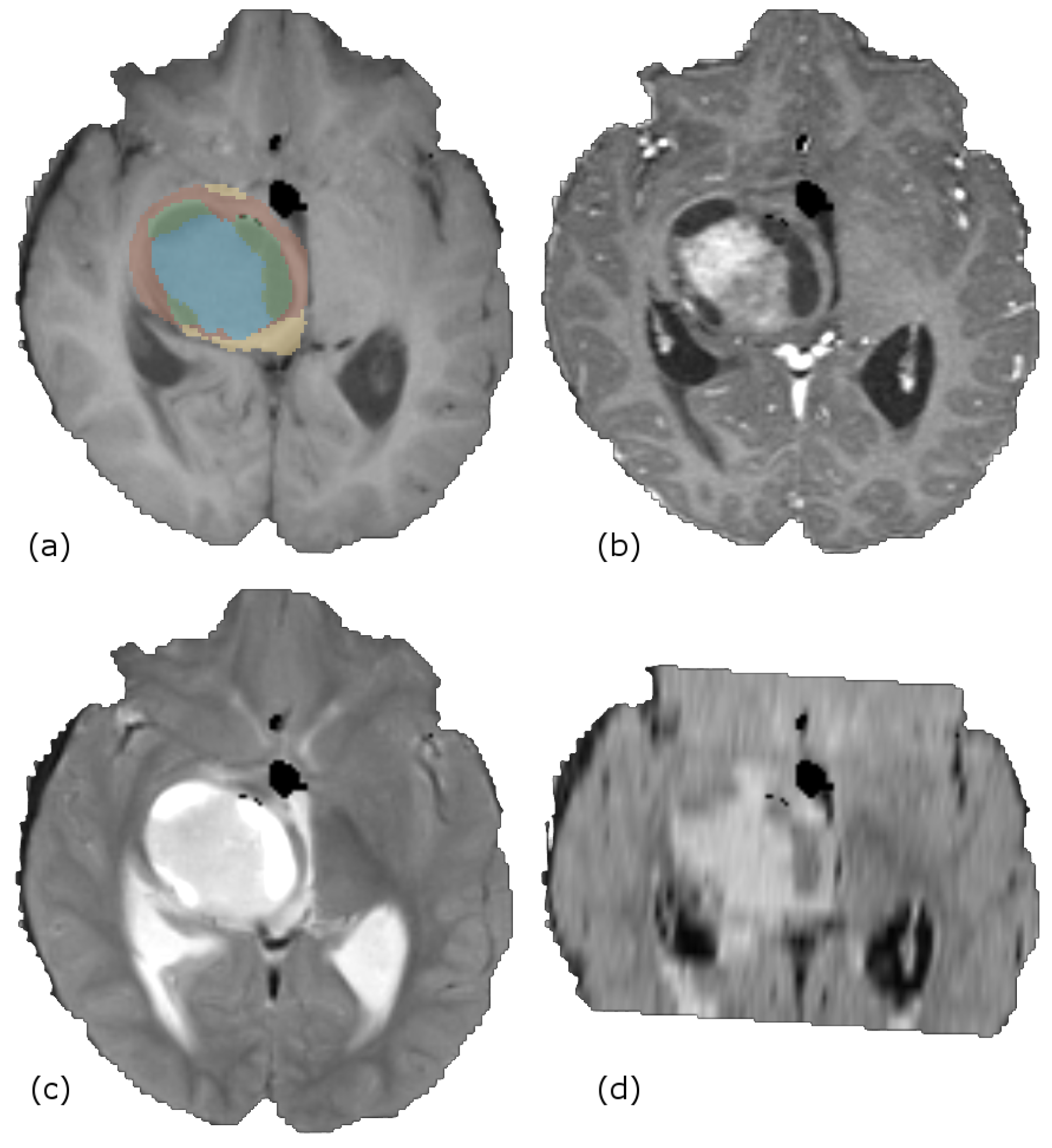
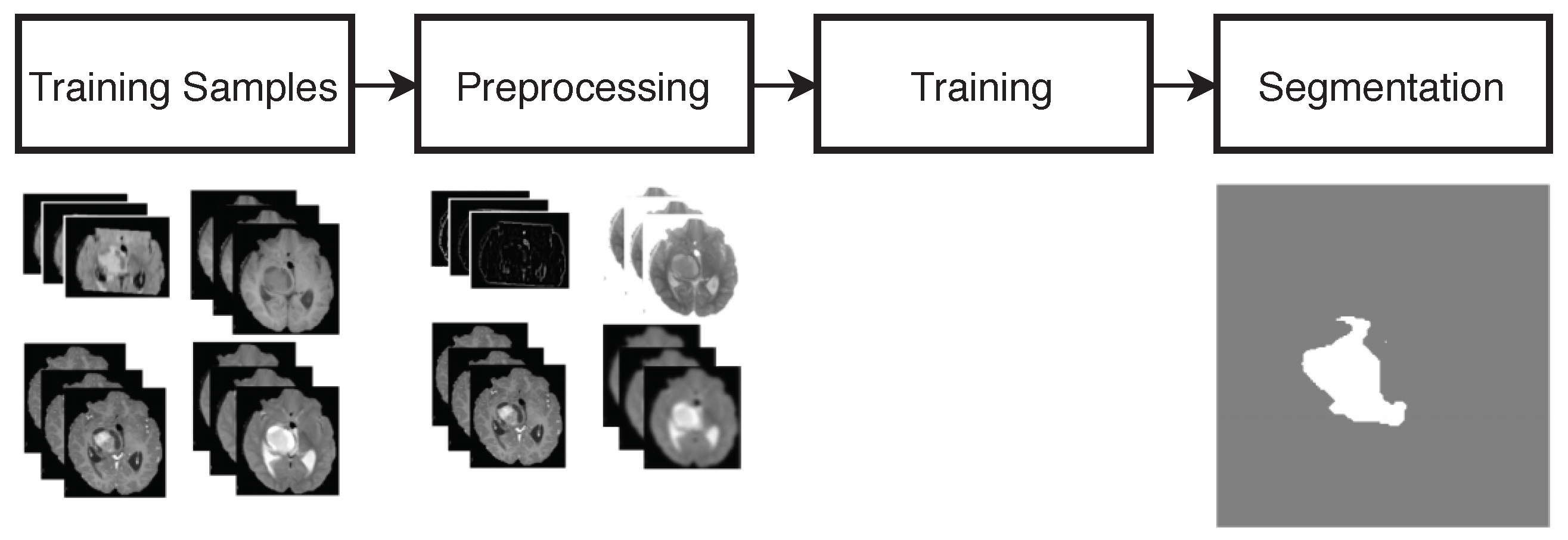

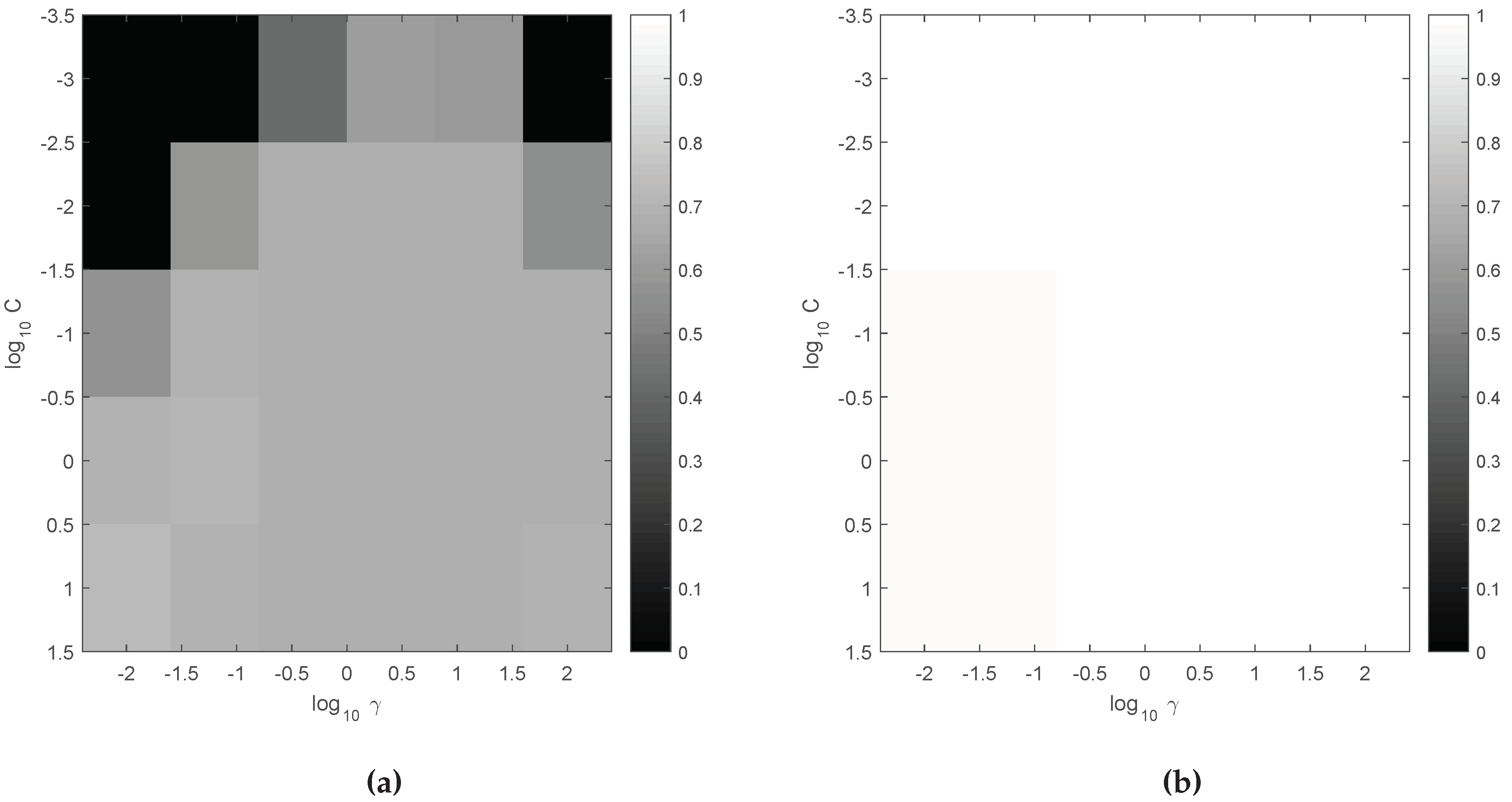

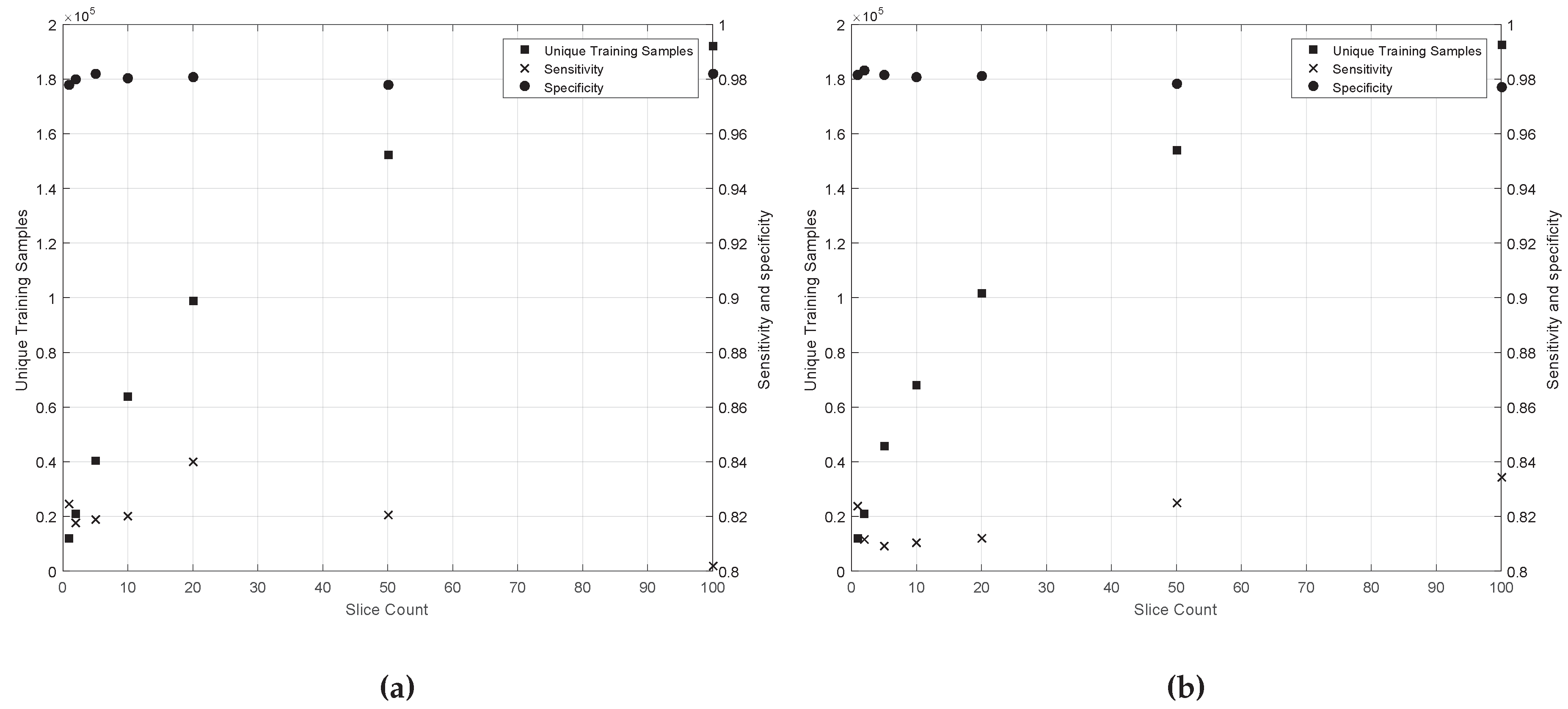

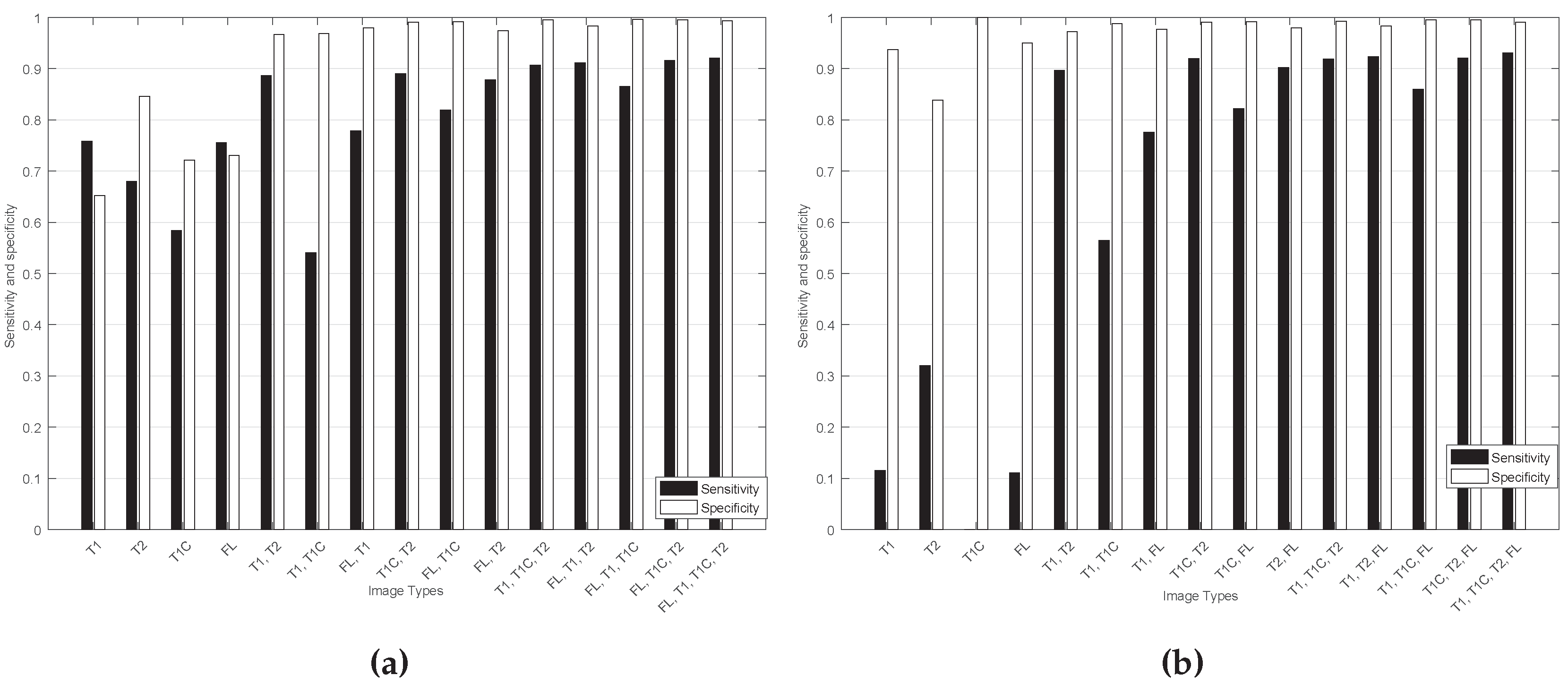
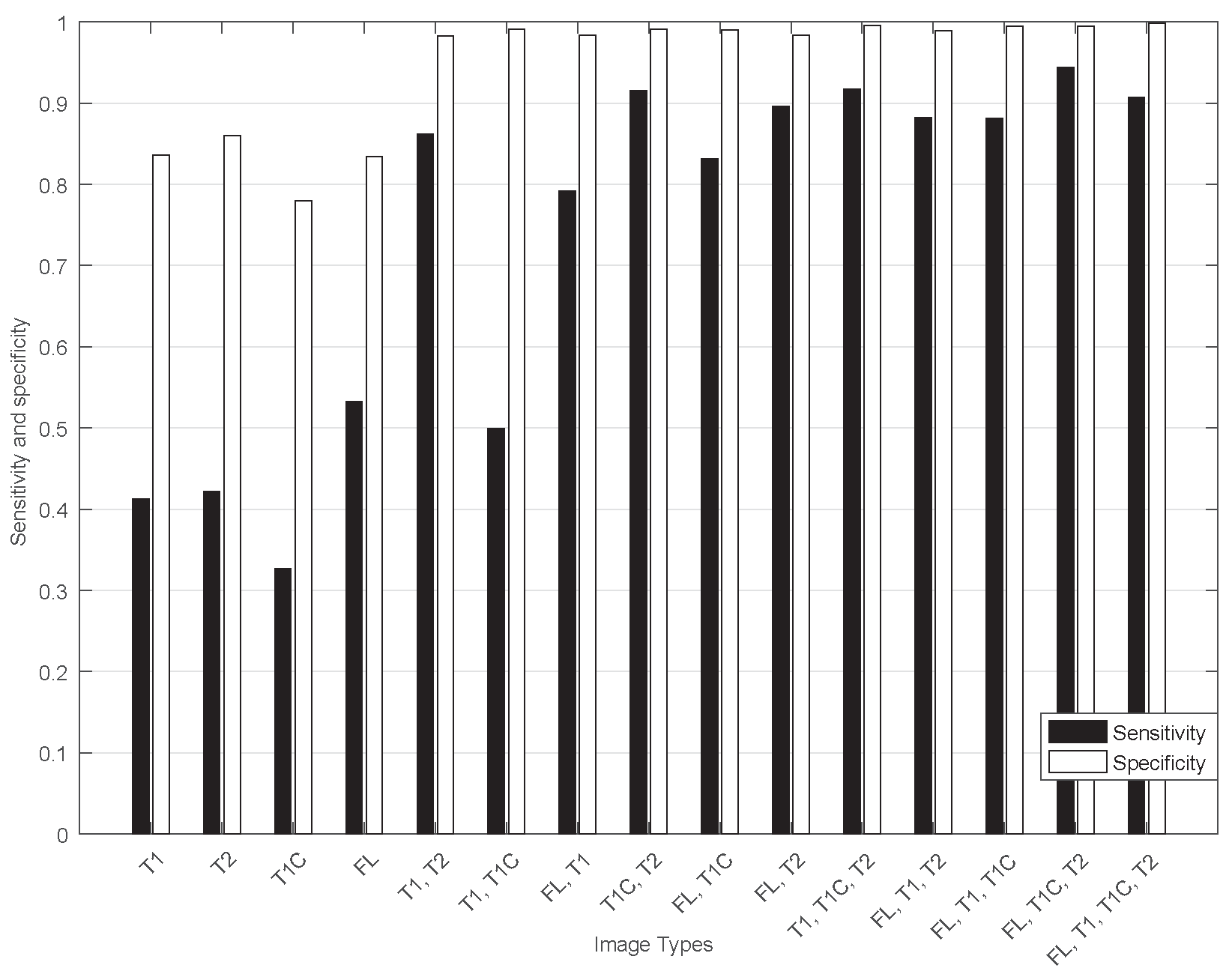

| Parameters | Sensitivity | Specificity | Acc. | Prec. | DICE | Jaccard | |
|---|---|---|---|---|---|---|---|
| C-SVM | γ = 1.0, C = 1.0 | 0.72 | 0.98 | 0.99 | 0.96 | 0.80 | 0.66 |
| N-SVM | γ = 10.0−3, N = 0.1 | 0.77 | 0.97 | 0.99 | 0.96 | 0.82 | 0.70 |
| RF | 0 % OOB, 0 random attributes, 1200 trees, node size 2 | 1.00 | 0.95 | 1.00 | 0.96 | 0.94 | 0.89 |
| Paper | Approach | DICE |
|---|---|---|
| This paper | RF | 0.43 |
| Geremia [21] | Spatial decision forests with intrinsic hierarchy | 0.32 |
| Kapás [16] | RF | 0.58 |
| Bauer [22] | Integrated hierarchical RF | 0.48 |
| Zikic [23] | Context-sensitive features with a decision tree ensemble | 0.47 |
| Festa [24] | RF using neighborhood and local context features | 0.50 |
© 2018 by the authors. Licensee MDPI, Basel, Switzerland. This article is an open access article distributed under the terms and conditions of the Creative Commons Attribution (CC BY) license (http://creativecommons.org/licenses/by/4.0/).
Share and Cite
Chalupa, D.; Mikulka, J. A Novel Tool for Supervised Segmentation Using 3D Slicer. Symmetry 2018, 10, 627. https://doi.org/10.3390/sym10110627
Chalupa D, Mikulka J. A Novel Tool for Supervised Segmentation Using 3D Slicer. Symmetry. 2018; 10(11):627. https://doi.org/10.3390/sym10110627
Chicago/Turabian StyleChalupa, Daniel, and Jan Mikulka. 2018. "A Novel Tool for Supervised Segmentation Using 3D Slicer" Symmetry 10, no. 11: 627. https://doi.org/10.3390/sym10110627
APA StyleChalupa, D., & Mikulka, J. (2018). A Novel Tool for Supervised Segmentation Using 3D Slicer. Symmetry, 10(11), 627. https://doi.org/10.3390/sym10110627





